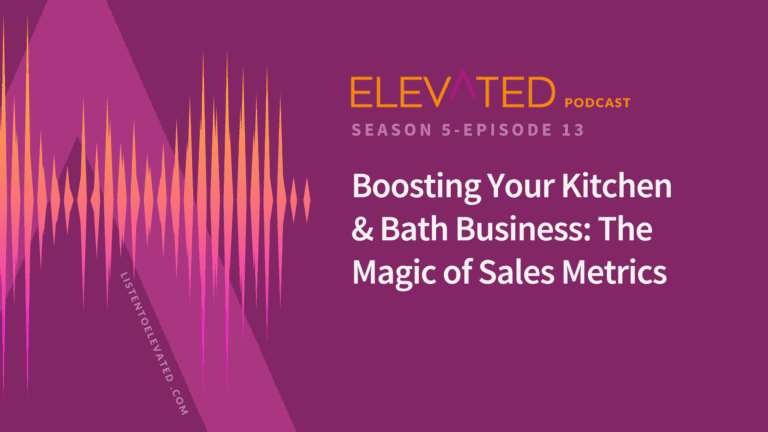Boosting Your Kitchen & Bath Business: The Magic of Sales Metrics

In the previous episode, we discussed the top three key performance indicators (KPIs) that a well-functioning sales system can offer, propelling your kitchen and bath business towards greater profitability. This time around, we’re venturing even deeper into the metrics that a sales system can provide, shedding light on how to diagnose issues if your KPI “check engine” light does happen to come on.
So, what exactly happens when one of your crucial KPIs starts showing signs of distress, or when you’re thinking about increasing ad spend or investing more in marketing efforts? That’s where additional metrics come into play, offering an in-depth view and helping you troubleshoot potential issues effectively.
Having your business data neatly organized within your system means you have these invaluable data points and analyses at your fingertips. Armed with this information, you can maximize your impact with minimal time investment. Easy access to metrics paves the path +to a more profitable business. You see, as an owner, when something warrants your attention, you can swiftly pinpoint the root of the problem, as opposed to wrestling with uncertainty, watching money trickle away from a subpar lead source or chasing unqualified prospects.
What are these additional sales metrics that a robust sales system can provide and how can you leverage them?
First up is your “Average Close Rate.” This metric offers valuable insights into both lead quality and process effectiveness. The close rate is the percentage of leads that result in a sales. A good close rate is above 50%, meaning that out of 10 leads, 5 of them became clients. If you find that your close rate is lower than 50%, you might want to investigate further. Are the leads of lower quality, or is there an issue with your sales process that’s hindering conversions? Monitoring your Average Close Rate can help you fine-tune your marketing, ensuring that you’re focusing on high-quality leads and optimizing your processes for better conversion rates.
Understanding and Optimizing Average Deal Value for Revenue Growth
Next we’ll look at “Average Deal Value.” This metric provides a clear picture of how many leads you need to reach your revenue target. The value of an average deal can fluctuate based on a variety of factors, and it’s important to monitor this metric over time. If you notice a downward trend, it could be that you are still closing the same number of deals, but they are for smaller amounts and it could mean that more deals (and leads) are required to hit your revenue target. On the flip side, if your Average Deal Value is increasing, you may need to consider capacity and timing issues, as these larger deals could take longer to close and deliver.
Evaluating Lead Quality: The Importance of Tracking Qualified Lead Percentage
Another metric to watch is “Percentage of Qualified Leads.” If, out of ten leads, only three are qualified as sales-ready, you may need to reevaluate your lead sources. If a significant percentage of your leads are unqualified, it’s time to rethink your lead generation strategy and focus on channels that deliver better-qualified prospects. This metric also provides insight into the effectiveness of your lead nurturing process and helps you allocate resources more efficiently.
Streamlining Sales: Analyzing the ‘Days in Stage’ Metric to Enhance Process Efficiency
Lastly, don’t overlook the “Number of Days in Each Stage” metric. This metric tracks how long leads remain in each stage of your sales process. It’s essential for identifying bottlenecks and process inefficiencies. For example, if a prospect is lingering too long in one stage, it’s a sign that they may need more attention or nurturing. By monitoring the number of days in each stage, you can uncover areas where leads often get stuck, refine your processes, and ensure a smoother, more efficient journey for your prospects.
Harnessing Sales Metrics for Business Growth: A Guide to Profitable Kitchen & Bath Design
These metrics serve as a way to know where to focus attention, illuminating potential areas for improvement, indicating lead quality, process efficiency, and the overall health of your sales system. Armed with this data, you can make more informed decisions about your lead sources, sales processes, and capacity planning, all while ensuring that your kitchen and bath design business remains on a path to profitability. The result is a more streamlined and profitable business, allowing you to focus your time and resources on what truly matters—designing beautiful spaces and delivering exceptional client experiences.
These supplementary metrics, combined with the core KPIs we discussed in the previous episode, form a comprehensive dashboard that can help you to manage your business more effectively. With this level of detail and data analysis, you can overcome challenges and maintain the predictability of your profitable business.
So, the next time you see the “check engine” light flicker in your business, remember that these metrics are your trusty tools for diagnosing and resolving the issue, helping your business stay on the road to success.
Coming up next, we’ll wrap up our series on KPIs by looking at their value not just as health indicators, but also as an information source on where to take action to maximize your profitability.

